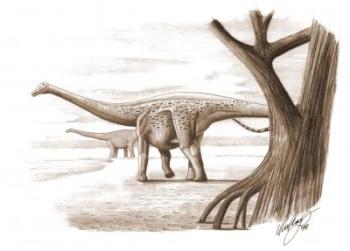A dinosaur mystery over a hundred years old has been unraveled according to a new study in the Proceedings of the National Academy of Sciences.
In 1895 a woman discovered dinosaur bones on her family estate in Transylvania, a region in present-day Romania. Fortunately, her brother was paleontologist Franz Baron Nopsca; he declared that the bones belonged to a dwarf sauropod, which he dubbed Magyarosaurus dacus. Yet, Nopsca’s declaration of a ‘dwarf’ dinosaur has been frequently debated and sometimes met with skepticism as researchers declared it was more likely just a young sauropod.
Fast-forward a hundred-and-fifteen-years and researchers with the University of Bonn have confirmed that Nopsca’s assessment was indeed correct. Contemporary scientists cut open the fossil bones to peer at the microstructure inside.
 Artists rendition of Magyarosaurus dacus. The tree presents a sense of the scale. Illustration by: Mihai Dumbrava, liliensternus.deviantart.com. |
“It’s astonishing that the microanatomy of these bones has been preserved for us to study after 70 million years,” say Koen Stein, one of the lead researchers, who carried out the study for his PhD. “Bone is a living tissue, and throughout an animal’s life it is constantly dissipating and building up again.”
The bones revealed that this small sauropod—the size of a horse—was not juvenile but a full adult.
“We were able to distinguish these rebuilding features in Magyarosaurus, which prove that the little dinosaur was fully grown,” Stein says.
“An animal the size of a horse may not seem like a dwarf to most people but, in sauropod terms, it’s tiny!” adds Martin Sander spokesperson of the Research Group on Sauropod Biology.
Sauropods include some of the largest animals to have ever walked the earth, some species reached over 30 meters (100 feet) in length and as tall as 18 meters (60 feet).
“Our study shows that dinosaurs on islands were subject to the same ecological and evolutionary processes that shape modern mammals,” says Sander.
Dwarfism often occurs on islands where species may not have the same amount of resources available as on the mainland, and so their body size evolves to suit their more constrained surroundings.
Citation: Koen Stein, Zoltan Csiki, Kristina Curry Rogers, David B. Weishampel, Ragna Redelstorff, Jose L. Carballido, and P. Martin Sander. Small body size and extreme cortical bone remodeling indicate phyletic dwarfism in Magyarosaurus dacus (Sauropoda: Titanosauria). PNAS 2010 : 1000781107v1-201000781.
Related articles
Prehistoric snake gobbled-up dinosaur babies

(03/02/2010) A fossilized snake has been discovered inside a titanosaur nest in India, leading researchers to conclude that the snake fed on newly-hatched dinosaur babies, rather than their eggs like modern snakes. Paleontologist and snake expert Jason Head says that the snake, known as Sanajeh indicus, lacked the wipe-jaws needed to swallow eggs, but just-hatched baby titanosaurs would have been perfect prey for the 3.5 meter (nearly 12 feet) long serpent. Titanosaurs belong to the sauropods, long-necked herbivorous dinosaurs which includes the world’s largest animals to ever walk the land.
48 ‘new’ species of dinosaur discovered
(02/09/2009) In just four years a University of Portsmouth palaeontologist has discovered 48 new species from the age of the dinosaurs.
Two strange carnivorous dinosaurs discovered in the Sahara
(02/12/2008) Two previously unknown species of dinosaur discovered in the Sahara were unusual meat-eaters, report scientists from the University of Chicago and the University of Bristol.